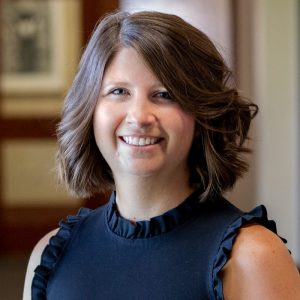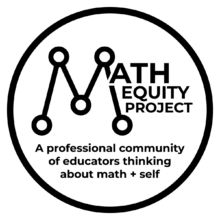
Introduction: Finding Purpose through “Storientations”
One bad math or English class can sour a student’s entire experience with the subject. Professional Learning Specialist Christina Stefonek, a math teacher for 10 years who now designs and facilitates mathematics and science professional learning programs at PLACE, has such a story she shares with other math educators during “storientations” at the Math Equity Project.
“In fifth grade, I was given a timed test and that shaped my math trajectory throughout the rest of my schooling, including college,” Stefonek recalled. “It messed with my perception of my mathematical ability for a very long time. I don’t want students to feel the way I did because of tracking in math. This is one piece of equity in mathematics.”

Math education has traditionally focused on memorization and repeated practice.
“As a student in the University of Wisconsin–Madison’s School of Education, I experienced math pedagogy that focuses on understanding the mathematical concepts and solutions,” Stefonek continued. “This is what I refer to as my math awakening. Doing math in this way with students helped me to change my view of what mathematics could be.”
As an example, she says students are required to input an X-value to calculate Y for a linear function, but they do not necessarily understand what that function is or why someone would use it in the real world.
“Now, math educators work with students to help them understand multiple ways to model linear functions and the connections between them,” she said. Students do this using real-world situations that are relevant to their lives, such as calculating the cost of their monthly cell phone bill over a period of time.”
(For more on this topic, read “My Math Equity Project ‘Storientation.’”
Building Equity in the Mathematics Classroom Requires Collaboration
The goal of the Math Equity Project is to collaborate as a community of math educators to find ways to teach math that will humanize our students and mathematics. Math isn’t simply solving for X and Y. This professional learning program for K-12 educators involves investigating, experiencing, and implementing research-based teaching practices that promote equity in math education.
Attendees partake in a one-week online summer institute followed by online monthly meetings on weeknights during the school year for continued collaboration. The program is co-facilitated by Stefonek, high school educator Mary Lee McKenzie, and teacher educator Gwyn Hughes. Drs. Nicole Louie and Priyanka Agarwal, assistant professors in the Department of Curriculum and Instruction, help design and facilitate projects.
Who Attends the Math Equity Project?
Those who attend the Math Equity Project run the gamut of instructional experience.
Mid-career educators are exploring ways to enhance learning, whereas new teachers are often looking for support in crafting their own approach to mathematics instruction. Some are nearing retirement while others work in administrative positions, as coaches, or at the district level. What unites them is a desire to bring equity in math instruction to their district. Stefonek explained:
Not only are we focused on math teaching that builds students’ deep conceptual understanding of mathematics through equitable math discourse practices, but we are also looking at students’ mathematical thinking. In addition to those things which have been researched for a long time and considered the best practice in math teaching, we consider the humanity of the people in the room who are doing the math.
Skylar Primm, an educator in the Montello School District, jumped at the chance to join the program.
“As an alum of the Greater Madison Writing Project, I was excited to be part of a similar professional learning experience around math teaching,” Primm said. “I just added a math license to my science licenses last summer, so I am only just starting to explore the professional literature and thinking around math instruction.” The Math Equity Project offered a way for Primm to join a network of supportive peers.
“I hope to learn what works for helping my students redevelop their mathematical identities in my classroom so that every student sees themself as a mathematician and recognizes that mathematics is relevant to their life.”
Themes of the Math Equity Project
 The Math Equity Project bases discussion and critical thinking around themes. New themes are introduced to attendees during the initial week of instruction and are revisited throughout the yearlong program.
The Math Equity Project bases discussion and critical thinking around themes. New themes are introduced to attendees during the initial week of instruction and are revisited throughout the yearlong program.
The theme they focus on every day? “Notice and name racism, sexism, classism, ableism, and other biases and sit with our own discomfort as necessary for learning and transformation,” Stefonek said.
Identity
The first theme of the Math Equity Project focuses on identity.
“We focus not only on the identities of students but our own identities, as well, and where we come from,” Stefonek said. “What made us the teachers we are? What sort of things affect the decisions we make? Where do our beliefs come from?”
Attendees are tasked with sharing a storientation like Stefonek’s. In them, they write about their relationships with mathematics.
“That was really powerful to hear everyone’s experiences in math, but also life, that helped shape them as a person,” Stefonek said.
Participants examine readings, videos, podcasts, and more, and then they discuss with each other what they’ve learned.
Culturally Relevant Activities
The group also focuses on culturally relevant activities. They look at inequities in Wisconsin such as why academic achievement gaps exist between white and Black students.
“By analyzing inequities in Wisconsin, we get a glimpse into the experiences that our students might have,” Stefonek explained. “We use a rubric to look at [whether something] is culturally relevant for students. Could it be done in a more effective way?”
Mathematical Discourse
The program also emphasizes mathematical discourse so that participants understand how to facilitate mathematical conversations. Explicit focus on mathematical discourse in the classroom also helps to support students in developing academic language which enables them to explain and justify the solutions they find.
“They just can’t say the answer is 10, they need to say why based on ideas and thinking,” Stefonek said.
“Groupworthy” Tasks
“Groupworthy” tasks are another large part of the program. Louie talks about how to choose math tasks that require the resources of the group. To make it groupworthy means that everyone has a specialty, everyone can contribute, and, like a sports team, each student in the group has ways to contribute based on their exclusive strengths. Being groupworthy ensures students see each other’s strengths in mathematics.
“Everyone has something to offer,” Stefonek said. “As teachers, how do we highlight those strengths students have and assign competence so we see each other as capable?”
Assigning competence is the concept of pointing out or giving opportunities for students to demonstrate their expertise in a certain subject area. The goal is for students to see the strengths of each individual, rather than only viewing a select few students as competent in a classroom.
Being smart in mathematics is also a bit misunderstood. What does it mean to be smart in mathematics? What did it mean traditionally? These are questions that each instructor considers during the course.
For example, instead of just finding a solution quickly, a new way of “being smart” in mathematics involves the ability to see a problem in multiple ways. So is listening to the solutions of others and trying out their strategies.
The ways students can be smart in mathematics have expanded and evolved.
Advocacy
The final big focus of the Math Equity Project is advocacy. How do we then advocate for these sorts of practices in our schools and districts? Stefonek helps identify opportunities for change and how to achieve them with students, parents, colleagues, and the system as a whole.
“That kicks off the action research everyone plans to do over the school year,” Stefonek said. “What is it they want to work on in their classroom and their school? How will they do that? As we meet every month throughout the year, we support each other in that process. That’s how we continue this work together.”
Creating change is a huge challenge, but it helps immensely to be in a collaborative space with other educators. Each month, the group meets to check in on progress and even make changes to some of their research goals.
Plans for attendees’ action research projects include:
- Doing projects that build student identities as mathematicians
- Finding ways to facilitate math discussions so that students’ mathematical thinking is revealed
- Making a rubric for mathematics talk
- Building an understanding of math identity among the teachers in the district and examining how math identity affects teaching and learning
- Using culturally relevant data in high school math lessons
- Building nontraditional assessments
- Increasing opportunities for English Learners to have an equitable voice in discussions
These ideas may evolve over the year, but flexibility is encouraged in what teachers want to research as they get data from students.
Closing
For Stefonek, the biggest benefit for the Math Equity Project participants is having a community of educators working toward shared goals.
“This is hard work. Having a community to come back to and share with and get feedback from is really important. And it’s so hard as an educator to find the time and find new resources. These educators already care so deeply that everything they are doing is in service of making their classrooms more relevant, equitable, meaningful, and understandable for their students. We’re providing a space for them to think about how they will do that with others.”
For Primm, continued learning and enriching students is a big part of the job. If the Math Equity Project can help him achieve his goals and those of his students, it’s a no-brainer to partake.
“Learning is part of human thriving, and every student deserves access to what they need to thrive,” he said. “In math in particular, we have traditionally sent messages to students that they are either good at it or not, and those messages take hold at a young age. Equity in the math classroom has the potential to transform lives by blowing up that good/bad paradigm and giving all students the ability to see themselves as mathematicians.”
Learn More
A new cohort of the Math Equity Project will begin in August.
